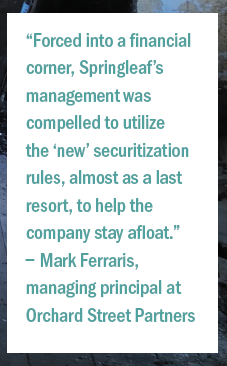The recent announcement by Chairman Ben Bernanke that the Federal Reserve would begin, in the unspecified future, scaling back purchases of mortgage-backed securities issued by Fannie Mae and Freddie Mac rocked an investor base that should have known this was coming for a long time.
But, as bond vigilantes, these investors began the not-soorderly rush to the exits, clearly unhappy with suggestions their years-old safety net would be removed.
In an effort to restore a level of calm, the president of the Minneapolis Federal Reserve, Narayana Kocherlakota, released a statement that described the stages of this tapering as influenced by thresholds, not dictated by triggers. Slow and steady would be the course, Kocherlakota suggested, while seizing the opportunity to criticize Bernanke’s influence on the markets via his highly covered Q&A sessions.
“These communications do leave the public with large amounts of residual uncertainty about the Committee’s likely course of policy choices when the recovery is more advanced,” Kocherlakota wrote. “The Committee could better achieve its policy goals if it were to reduce this uncertainty through communicating more information about its likely reactions to additional economic eventualities.”
 None of this would seem so impactful if there remained a meaningful private mortgage bond market to which all these investors could flood. And no one seemed nearly as troubled to see the market for jumbo residential mortgage-backed securities slowly come spurting back to life earlier this year. But the private market is what it is, and it’s capable of throwing its own curve balls.
None of this would seem so impactful if there remained a meaningful private mortgage bond market to which all these investors could flood. And no one seemed nearly as troubled to see the market for jumbo residential mortgage-backed securities slowly come spurting back to life earlier this year. But the private market is what it is, and it’s capable of throwing its own curve balls.
Since the end of the financial crisis — or the beginning for that matter — the space has been largely dominated by carbon-copy offerings from Redwood Trust. But lately, deals from big gun JPMorgan Chase jumped onto the stage along with smaller players such as EverBank.
Yet, news from Springleaf Financial that it was doing the same did not receive the same amount of fanfare. Why this happened is a point of debate. It could be argued that the collateral — seasoned first-lien, fixed- and adjustable-rat residential mortgages secured by subprime borrowers — lacked the “oomph” to garner celebration. The naughty-by-nature status quo of subprime paper could explain why Springleaf is not publicly popping champagne corks over the deal.
The unpaid principal balance is around $835.1 million, and American General originated 54.4% of the mortgages included. Other financial institutions in the deal include Wilmington Finance, The Mortgage Store Co. and Equity One.
Mark Ferraris, a managing principal at Orchard Street Partners, blogged about criticism surrounding the deal. “As further evidence that the U.S. residential mortgage-backed bond market continues to sputter, the background details on Springleaf Financial’s recent subprime issuance are enough to make any securitization professional wince!” he wrote.
“Forced into a financial corner, Springleaf’s management was compelled to utilize the ‘new’ securitization rules, almost as a last resort, to help the company stay afloat.
“They have chosen to, once again, dip into their legacy mortgage portfolio to raise nearly US$1 billion through a securitization structure.”
As of press time, Springleaf is miles away from filing its much-needed initial public offering with the Securities and Exchange Commission. And equity markets are not improving in the meantime.
But the Street is getting confused. Equities investors can look at the RMBS deal as a shot in the dark. Whereas from a bond investor perspective, there is nothing wrong with Springleaf.
Standard & Poor’s issued a pre-sale on the deal and outlined the series of checks and balances that go into rating such a deal. The standard operating procedure now includes checks on anti-predatory lending as part of the third party due diligence. All the while S&P analysts have these details in the backs of their minds.
They note that as of Jan. 1, 2012, Springleaf ceased originating new real estate loans nationwide in order to focus on other consumer lending products and its insurance operations.
The company has withdrawn its mortgage origination business from approximately 14 states and has also consolidated operations within another 26, reducing its branch count significantly.
Springleaf itself is woefully rated at triple-C as of April 1, 2013.
Within the Springleaf Mortgage Loan Trust 2013-1 securitization, 0.44% of the mortgage loans were seasoned less than two years. The majority of the loans (98%) were seasoned more than four years. It’s worth repeating: seasoned more than four years. That’s because this is a strong argument for the performance of the underlying collateral. And this is before applying credit enhancement.
The Springleaf deal offers three major forms of credit enhancement, none of which are the iffier types, such as credit default swaps and the like. More tangible loss triggers instead cushion Springleaf. The recourse to senior investors is in the form of excess interest, but there are a few covenants to this. For example, the servicer will not cover force-placed insurance nonpayment or delinquent taxes, according to the representations and warranties of the deal.
Also, the S&P pre-sale notes: “If the unpaid principal balance is increased, the servicing fees are expected to increase because the servicer fee is based off the unpaid principal balance. This would reduce the net WAC Cap and may reduce interest payments owed to the noteholders.”
Beyond this, losses that cannot be absorbed by the excess interest will not be realized unless the amount of overcollateralization is exhausted. Further, the interest reserve fund stands at $9.73 million, but it should be noted there is no mechanism to replenish the coffers. At any rate, the analysts are unconcerned and predict no loss for senior noteholders. For mezzanine investors, there is the risk of losses, but these investors normally chase risk.
But even Ferraris himself concedes at the end of his post that the Springleaf RMBS may be falling victim more to a lack of confidence in the market, which, he suggests, can be fixed by taking a more measured approach to the deal. In a nutshell, his analysis underscores the issue at the core of the deal.
“It used to be that securitization ran a close second to unsecured financing alternatives in the mortgage markets,” Ferraris wrote. “For some issuers, it was the preferred choice. “If government regulators need any further proof that ‘the cure is killing the patient,’ look at the hoops that Springleaf needed to jump through and the fact that they are only looking to securitization as a last-ditch option.
“Some would argue that Springleaf is lucky to have gotten a subprime deal rated and in the market in the first place. We don’t see it that way. Something has to give!” he concludes. “Nothing that a little bit of pragmatism and a few less ideologues in the room wouldn’t cure.”
It’s a sentiment that, for the time being, remains largely lost on the panicky mortgage bond investor space.



